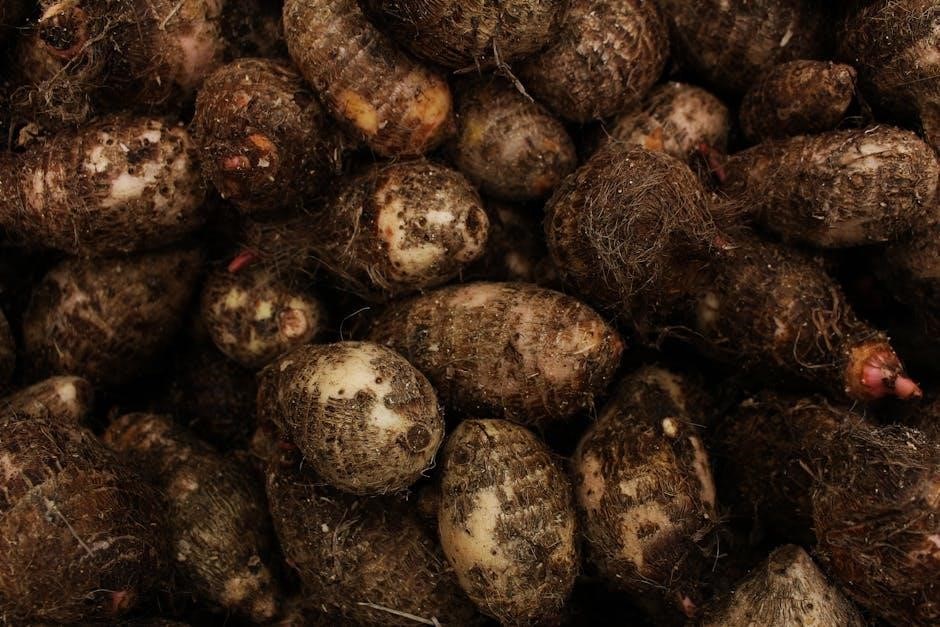Resistant starch is a carbohydrate that resists digestion in the small intestine and ferments in the large intestine‚ acting like dietary fiber. Found in beans‚ lentils‚ whole grains‚ unripe bananas‚ and chilled cooked rice or potatoes‚ it offers various health benefits‚ including improved gut health and blood sugar control.
1.1 Definition of Resistant Starch
Resistant starch (RS) is a type of carbohydrate that resists digestion in the small intestine and ferments in the large intestine. Unlike regular starch‚ it is not fully broken down into glucose during digestion‚ behaving similarly to dietary fiber. This unique property allows it to serve as a prebiotic‚ promoting beneficial gut bacteria growth. Resistant starch is classified into four types based on its resistance mechanisms and sources. It is naturally present in various foods‚ including legumes‚ whole grains‚ and unripe fruits‚ and can also be produced commercially for use in food products. Its indigestible nature contributes to its potential health benefits.
1.2 Importance of Resistant Starch in Nutrition
Resistant starch plays a significant role in promoting digestive health and overall well-being. It acts as a prebiotic‚ feeding beneficial gut bacteria‚ which supports a healthy gut microbiome. This fermentation process produces short-chain fatty acids‚ such as butyrate‚ which are essential for colon health and may reduce inflammation. Resistant starch also aids in blood sugar regulation by slowing glucose absorption‚ making it beneficial for managing insulin sensitivity. Additionally‚ it contributes to satiety and weight management by delaying gastric emptying and reducing calorie absorption. Its ability to enhance immune function and improve nutrient absorption further highlights its importance in a balanced diet. Incorporating resistant starch into meals can have profound positive effects on both digestive and systemic health.

Types of Resistant Starch
Resistant starch is classified into four types: RS1 (found in whole grains‚ seeds‚ and legumes)‚ RS2 (in unripe bananas and raw potatoes)‚ RS3 (formed during retrogradation in cooked‚ chilled foods)‚ and RS4 (synthetic‚ chemically modified starch). Each type varies in structure and resistance mechanisms‚ providing unique benefits for gut health and nutrition.
2.1 RS1: Resistant Starch Type 1
RS1‚ or Resistant Starch Type 1‚ is found in whole grains‚ seeds‚ and legumes. It resists digestion due to its entrapment within plant cell walls‚ which protect it from enzymatic breakdown in the small intestine. This type of resistant starch is particularly abundant in foods like whole wheat‚ barley‚ oats‚ and various beans. RS1 plays a significant role in promoting gut health by serving as a prebiotic‚ fostering the growth of beneficial gut bacteria. It also contributes to dietary fiber intake‚ aiding in digestion and satiety. Incorporating RS1-rich foods into meals can enhance overall nutritional balance and support digestive well-being.
2.2 RS2: Resistant Starch Type 2
RS2‚ or Resistant Starch Type 2‚ is naturally present in unripe bananas‚ raw potatoes‚ and certain starchy foods. Its resistance to digestion is due to its granular structure‚ which remains intact in the small intestine. RS2 acts as a prebiotic‚ feeding beneficial gut bacteria and promoting a healthy gut microbiome. It is also known to improve insulin sensitivity and support blood sugar regulation. Incorporating RS2-rich foods‚ such as green bananas or raw potato starch‚ can enhance dietary fiber intake and provide additional metabolic benefits. RS2 is a valuable component of a balanced diet‚ offering both digestive and overall health advantages.
2.3 RS3: Resistant Starch Type 3
RS3‚ or Resistant Starch Type 3‚ is formed during the retrogradation process of starches‚ typically when cooked starchy foods like rice‚ potatoes‚ and pasta are cooled. This process rearranges the starch molecules into a crystalline structure‚ making them resistant to enzymatic digestion. RS3 is particularly beneficial for gut health‚ as it ferments in the large intestine‚ producing short-chain fatty acids that nourish colon cells and support a healthy gut microbiome. Incorporating chilled‚ cooked starches into meals can boost RS3 intake‚ offering advantages such as improved glucose metabolism and enhanced immune function. RS3 is a versatile and easily accessible form of resistant starch in everyday diets.
2.4 RS4: Resistant Starch Type 4
RS4‚ or Resistant Starch Type 4‚ is a synthetic or modified form of resistant starch‚ typically produced through chemical or enzymatic treatments. It is not naturally occurring but is commonly added to processed foods to enhance their nutritional profile. RS4 is highly resistant to digestion in the small intestine and ferments in the large intestine‚ providing benefits similar to other resistant starch types‚ such as improved gut health and blood sugar regulation. This type is often used in food products like bread‚ breakfast cereals‚ and snacks‚ offering a convenient way to increase resistant starch intake without relying on traditional food sources. Its versatility makes it a popular choice in modern food manufacturing.

Food Sources of Resistant Starch

Resistant starch is naturally found in whole grains‚ legumes‚ unripe bananas‚ raw potatoes‚ and chilled cooked rice and potatoes‚ offering diverse dietary options for optimal health benefits.
3.1 Whole Grains
Whole grains are an excellent source of resistant starch‚ particularly RS1‚ which is bound within fibrous cell walls. Grains like oats‚ barley‚ quinoa‚ rye‚ and whole wheat contain significant amounts of resistant starch due to their intact cell structures. These grains resist digestion in the small intestine and ferment in the large intestine‚ providing prebiotic benefits. Incorporating whole grains into meals supports gut health and improves blood sugar control. Practical ways to include whole grains in the diet include using them in bread‚ porridges‚ or as side dishes. Their high fiber content also enhances satiety‚ making them a nutritious addition to a balanced diet. They are versatile and easily integrated into various cuisines.
3.2 Legumes and Beans

Legumes and beans are rich in resistant starch‚ particularly RS1‚ due to their fibrous cell walls. They resist digestion in the small intestine and ferment in the large intestine‚ promoting gut health. Common legumes like lentils‚ chickpeas‚ black beans‚ and kidney beans are excellent sources of resistant starch. These foods are not only high in fiber but also provide essential nutrients like protein and minerals. Incorporating legumes into meals supports blood sugar control and enhances satiety. They are versatile and can be used in soups‚ salads‚ or as main dishes. Regular consumption of legumes and beans contributes to a balanced diet and offers numerous health benefits. They are also eco-friendly and sustainable food choices‚ making them a great addition to various cuisines.
3.3 Unripe Bananas
Unripe bananas are a rich source of resistant starch‚ specifically RS2‚ which is resistant to digestion in the small intestine. As bananas ripen‚ the resistant starch content decreases‚ making unripe bananas the best choice for maximizing RS intake. The high starch content in green bananas supports gut health by fermenting in the large intestine‚ promoting beneficial bacteria growth. Incorporating unripe bananas into meals can improve blood sugar control and enhance satiety. They can be consumed raw‚ cooked‚ or used in recipes like smoothies or baked goods. Regular consumption of unripe bananas contributes to overall digestive well-being and provides essential nutrients. This makes them a valuable addition to a balanced diet focused on resistant starch-rich foods.
3.4 Raw Potatoes
Raw potatoes are a significant source of resistant starch‚ particularly RS2‚ which remains undigested in the small intestine. The starch in raw potatoes is resistant due to its unique molecular structure‚ which ferments in the large intestine‚ supporting gut health. Cooking potatoes breaks down this structure‚ reducing RS content. Raw potatoes can be safely consumed in moderation‚ though they may cause digestive discomfort in some individuals. They are a valuable addition to diets focused on improving gut microbiota and blood sugar regulation. Including raw potatoes in salads or as a snack enhances resistant starch intake‚ contributing to overall digestive and metabolic well-being. This makes them a nutritious choice for those seeking RS-rich foods.
3.5 Chilled Cooked Rice
Chilled cooked rice is a rich source of resistant starch‚ particularly RS3‚ which forms when cooked rice is cooled. This process allows the starch molecules to recrystallize‚ making them resistant to digestion in the small intestine. RS3 ferments in the large intestine‚ promoting gut health by feeding beneficial bacteria. Incorporating chilled cooked rice into meals can help regulate blood sugar levels and improve digestive function. It is a convenient and accessible way to boost resistant starch intake‚ especially when prepared ahead of time or used in salads. Chilling rice after cooking maximizes its resistant starch content‚ making it a practical choice for those seeking to enhance their dietary fiber-like intake naturally.
3.6 Chilled Cooked Potatoes
Chilled cooked potatoes are an excellent source of resistant starch‚ specifically RS3‚ which forms when cooked potatoes are cooled. This process allows the starch molecules to recrystallize‚ making them resistant to digestion in the small intestine. RS3 ferments in the large intestine‚ promoting gut health by feeding beneficial bacteria. Chilled potatoes are also low on the glycemic index‚ helping regulate blood sugar levels. To maximize resistant starch content‚ potatoes should be cooked‚ cooled‚ and refrigerated. Reheating does not significantly reduce RS3 levels‚ making chilled cooked potatoes a convenient and nutritious addition to meals. They can be easily incorporated into salads or served as a side dish‚ providing a natural way to boost dietary fiber-like benefits and support overall digestive well-being.
Health Benefits of Resistant Starch
Resistant starch improves gut health‚ regulates blood sugar‚ aids in weight management‚ and enhances immune function‚ offering a natural way to support overall well-being.
4.1 Improved Gut Health
Resistant starch significantly enhances gut health by promoting the growth of beneficial bacteria‚ such as Bifidobacteria and Lactobacilli. It ferments in the large intestine‚ producing short-chain fatty acids like butyrate‚ which nourish colon cells‚ reducing inflammation and improving gut barrier function. This process also inhibits the growth of harmful bacteria‚ balancing the gut microbiome. A healthy gut microbiome supports immune function‚ digestion‚ and overall well-being. Foods rich in resistant starch‚ such as beans‚ lentils‚ whole grains‚ and unripe bananas‚ are excellent ways to incorporate this beneficial carbohydrate into your diet. Regular consumption can lead to long-term improvements in gastrointestinal health and disease prevention.
4.2 Blood Sugar Control
Resistant starch plays a crucial role in regulating blood sugar levels by slowing down carbohydrate digestion and absorption. It reduces the glycemic index of foods‚ preventing sharp spikes in blood glucose. This makes it particularly beneficial for individuals with diabetes or those at risk of developing insulin resistance. The fermentation of resistant starch in the gut produces short-chain fatty acids‚ such as butyrate‚ which improve insulin sensitivity and glucose uptake in cells. Incorporating resistant starch-rich foods like whole grains‚ legumes‚ and unripe bananas into meals can help maintain stable blood sugar levels and support overall metabolic health. This makes it a valuable dietary component for blood sugar management.
4.3 Weight Management
Resistant starch supports weight management by promoting satiety and reducing overall calorie intake. It slows digestion‚ keeping you feeling fuller for longer‚ which can help control portion sizes and prevent overeating. Additionally‚ resistant starch increases the body’s energy expenditure by enhancing metabolic rate. The fermentation process in the gut produces short-chain fatty acids‚ which improve fat oxidation and reduce fat storage; Foods rich in resistant starch‚ such as whole grains‚ legumes‚ and unripe bananas‚ are also typically low in calories and high in fiber‚ making them ideal for weight management. This combination of effects makes resistant starch a valuable component of a weight-loss or maintenance diet.
4.4 Enhanced Immune Function
Resistant starch enhances immune function by promoting a healthy gut microbiome. The fermentation of resistant starch in the large intestine produces short-chain fatty acids‚ such as butyrate‚ which support the integrity of the gut barrier. This prevents harmful pathogens from entering the bloodstream‚ strengthening immune defense. Additionally‚ these fatty acids reduce inflammation‚ which can impair immune function. A balanced gut microbiome also supports the production of immune cells‚ such as macrophages and natural killer cells‚ enhancing the body’s ability to fight infections. Incorporating resistant starch-rich foods‚ like whole grains and legumes‚ can therefore play a significant role in maintaining robust immune health.

How to Incorporate Resistant Starch into Your Diet
Incorporate resistant starch into your diet by consuming whole grains‚ beans‚ unripe bananas‚ and cooked‚ chilled potatoes and rice. These foods naturally boost RS intake.
5.1 Practical Tips for Increasing RS Intake
To boost resistant starch intake‚ incorporate whole grains‚ beans‚ and legumes into meals. Eat unripe bananas or add them to smoothies for natural RS. Cook and chill rice or potatoes to enhance RS content. Include raw potatoes in salads or as a side dish. Consume fermented foods like yogurt‚ which support gut health and RS fermentation. Plan meals with RS-rich ingredients to ensure daily intake. Vary food sources to maximize benefits and maintain a balanced diet.
5.2 Meal Ideas Rich in Resistant Starch

Start your day with overnight oats made with chia seeds and unripe banana slices. For lunch‚ try a hearty salad featuring chickpeas‚ quinoa‚ and diced raw potato. Dinner could include lentil soup with barley or a stir-fry with cooled‚ cooked rice. Snack on rice cakes topped with almond butter and green banana slices. Incorporate RS-rich ingredients into familiar dishes‚ like adding beans to chili or using whole grains for pasta. Pair cooked‚ chilled potatoes with roasted vegetables for a satisfying side. These meals not only boost RS intake but also offer balanced nutrition and delicious flavors.
5.3 Storage and Preparation Methods
Proper storage and preparation are key to maintaining resistant starch content. Store whole grains‚ legumes‚ and unripe bananas in cool‚ dry places to preserve their RS. For cooked foods like rice and potatoes‚ cooling them after cooking and refrigerating for at least 24 hours enhances RS retention. Reheating these chilled starches minimally affects their RS content. Raw potatoes and green bananas should be consumed uncooked to maximize RS intake. Cooking methods like boiling or steaming can break down some RS‚ so minimal processing is recommended. Incorporating these strategies ensures that resistant starch remains intact‚ providing its full nutritional benefits in your diet.

Future Trends and Research
Research on resistant starch is expanding‚ focusing on novel sources and health impacts. Innovations in production aim to enhance accessibility and global nutritional benefits.
6.1 Emerging Studies on Resistant Starch
Recent research highlights the expanding interest in resistant starch‚ focusing on its diverse health benefits and potential applications. Studies are exploring its impact on gut microbiota‚ insulin sensitivity‚ and weight management. Advances in food technology are enabling the creation of resistant starch-enriched products‚ catering to growing consumer demand for functional foods. Additionally‚ investigations into the long-term effects of resistant starch consumption are providing deeper insights into its role in chronic disease prevention. These developments underscore the importance of resistant starch as a key area of nutritional science‚ with ongoing studies expected to uncover even more benefits and innovative uses.
6.2 Innovations in Resistant Starch Production
Modern advancements in food technology have led to innovative methods of producing resistant starch. These include modified cooking and cooling processes‚ enzymatic treatments‚ and the use of plant breeding techniques to enhance natural resistant starch content. Such innovations are making it easier to incorporate resistant starch into a variety of food products‚ from baked goods to snacks. Additionally‚ the development of resistant starch powders and flours is enabling food manufacturers to create functional ingredients that maintain the nutritional benefits of resistant starch while offering versatility in formulation. These production advancements are paving the way for a wider availability of resistant starch-enriched foods in the market.
Resistant starch is a valuable dietary component offering numerous health benefits‚ including improved gut health and blood sugar regulation‚ making it a beneficial addition to a balanced diet.
7.1 Summary of Key Points
Resistant starch is a dietary carbohydrate that resists digestion in the small intestine and ferments in the large intestine‚ functioning similarly to fiber. It is naturally found in foods like beans‚ lentils‚ whole grains‚ unripe bananas‚ and chilled cooked rice or potatoes. Resistant starch is classified into four types‚ each with unique properties and sources. It offers significant health benefits‚ including improved gut health‚ enhanced blood sugar control‚ and support for weight management. Incorporating resistant starch into the diet can be achieved through practical dietary adjustments and meal planning. Overall‚ resistant starch is a valuable component of a balanced diet‚ promoting long-term health and well-being.
7.2 Final Thoughts on Resistant Starch Foods
Resistant starch is a valuable component of a healthy diet‚ offering numerous benefits such as improved gut health‚ blood sugar regulation‚ and weight management. Found naturally in foods like beans‚ lentils‚ whole grains‚ and unripe bananas‚ it provides a simple way to enhance nutritional intake. Incorporating resistant starch into meals can be achieved through practical dietary adjustments‚ making it an accessible choice for promoting overall well-being. As research continues to uncover its benefits‚ resistant starch is gaining attention as a key player in supporting long-term health. Its natural prevalence in everyday foods makes it an easy and effective addition to a balanced lifestyle;

References and Further Reading
Scientific studies and guides on resistant starch foods are available in PDF formats‚ including resistant starch content in starchy foods and resistant starch health benefits.
8.1 Scientific Studies on Resistant Starch
Scientific studies highlight the benefits of resistant starch‚ with research emphasizing its role in improving gut health and regulating blood sugar levels. Studies have identified RS1‚ RS2‚ and RS3 as key types‚ each with distinct health benefits. For instance‚ RS2‚ found in unripe bananas and raw potatoes‚ has been shown to enhance insulin sensitivity. Similarly‚ RS3‚ formed in cooked and chilled foods like rice and potatoes‚ supports weight management. These findings are supported by resistant starch content analyses in various foods‚ providing a comprehensive understanding of its nutritional value. Further reading on these studies is available in detailed PDF guides on resistant starch foods.

8.2 Recommended Resources for Resistant Starch Foods
For detailed insights‚ refer to the PDF document on resistant starch content in starchy foods‚ which provides a comprehensive list of RS-rich foods. Studies by researchers like SN Khairatun and JI Boullata offer valuable data on resistant starch’s health benefits. The PLANTGEN 2023 conference proceedings also explore advancements in plant genetics and stress resistance‚ relevant to RS production. These resources are essential for understanding the nutritional and scientific aspects of resistant starch‚ offering practical dietary recommendations and research-backed findings for those seeking to incorporate RS into their meals.

No Responses